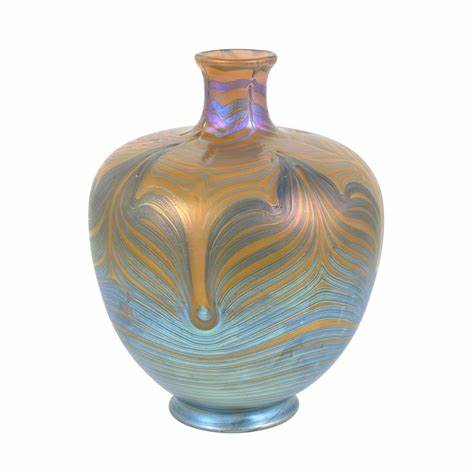After the great success of the Paris World Exhibition of 1900, the Loetz company experienced a great economic boom. Naturally, glassblowers created new and extraordinary vases, which followed the decor of the world exhibition.
One of these vases, made between 1900 and 1902, also belonging to the “Phenomen Genre”, is known by its name pattern 802. It is signed “Loetz Austria”, is 21 cm high, 16 cm wide and just as deep.
Some decors are combined with different shapes of vases, and as a result, similar variants were created. This one is different. In the case of the “Phenomenon Genre” 802, the present decoration is applied only to this vase shape. It is extremely rare. Only a few copies are known. Two of them are in collections of museums. One is in the Bröhan Museum in Berlin, the other is in the Passau Glass Museum. Another is privately owned and one in the Kunsthandel Nikolaus Kolhammer.
The decor is exceedingly complex and of exceptional beauty. The vase has a light pink ground (Loetz internal designation “metal red”). On the surface cobalt blue are spun, and in the upper part, silver-yellow oxide strings. After that, while still hot, they have been warped upwards and downwards with tongs, transformed into four symmetrical feather patterns. The resulting surface of the artwork looks almost like a beach with shallow water. As if in the glow of the Southern Sea sun, blue tones shimmer from light blue to turquoise and purple at the vase opening. One could almost believe that the beach and the shallow sea of a Southern Sea island have been spun onto a Loetz vase.
Overall, the classic and elegant vase shape beautifully accentuates the very complex and playful decor. It is a masterpiece of the Loetz workshop after 1900.
A completely different vase from 1901 is particularly striking with its tall twisted shape. Originally, Christoph Dresser designed this vase for another glass firm. Loetz decided to include it in its production program around 1900. It is signed ,,Loetz Austria” and known under the name Dekor Phänomen Genre ¼.
The 32 cm high vase stands out especially due to its tapering shape towards the top. In addition, large drops of varying lengths emphasize the dynamics of the twisted glass body and form a unique contrast to the uniformly warped, horizontal decor. Shimmering silver, almost pearly, covers an orange and rust red. Those colors reminiscent of a sunrise.
Another vase, made around 1902, belongs to the decor “Argus” and is one of the most popular variants from the family of the phenomenon genre. Silver oxide patterns create the impression of ice blue eyes on a rust red background. With spun silver eyelet threads, this Loetz-owned design is one of the most sophisticated decorations.
Here, the Bohemian glass manufactory was strongly oriented and inspired by the Secessionist style. The style refers to a group of artists, including Gustav Klimt, which at the time, represented the aesthetic avant-garde of Vienna.
The shimmering silver particles seem to float as if they are moving on a water surface, with the bluish wave-like silver threads undulating and giving the pattern a uniform dynamic. The spun-on decoration is particularly beautiful on the hazel ground, which graduates downward to a lighter hue.
It is called decor ,,Argus” because the pattern is reminiscent of eyes. Argus is a giant from Greek mythology, who had eyes all over his body. Even when he slept, some eyes remained open and could vigilantly observe everything around him. When Zeus was looking for a new lover and his choice was Io, his jealous wife Hera, had Io guarded by Argus so that Zeus would not seduce her.
However, the king of the gods sent Hermes to Argus, who was no match for his divine powers. Hermes killed Argus and Zeus seduced Io. Hera took pity on Argus and made him immortal. She put all his eyes on the plumage of the peacocks. From now on, these were to be protectors and companions of the Queen of Olympus.
Thus, like the beautiful plumage of peacocks, shimmering blue and green, Loetz vases also bear the divine attributes of Hera, making them all the more immortal objects of art.















